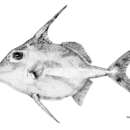Diagnostic Description
provided by Fishbase
Pelvis wide between bases of pelvic-fin spines (5 to 6.6% SL), its width 3.2 to 4.5 (usually slightly less than 4) times in length of pelvis. Caudal peduncle short, 19.2 to 23% SL (Ref 9804).
Trophic Strategy
provided by Fishbase
Inhabits sandy and muddy flat of coastal areas. Feeds on benthic invertebrates.
- Recorder
- Drina Sta. Iglesia
Biology
provided by Fishbase
Inhabits sandy and muddy flat of coastal areas. Feeds on benthic invertebrates. Marketed fresh.
Importance
provided by Fishbase
fisheries: minor commercial; price category: unknown; price reliability:
Comprehensive Description
provided by Smithsonian Contributions to Zoology
Tripodichthys oxycephalus (Bleeker)
The adductor arcus palatini is well developed, being of quite substantial thickness beneath the eye. The adductor operculi possesses a small anterior section which inserts on the posterodorsomedial face of the hyomandibular. The hyohyoidei adductores are as described for T. biaculeatus, and the ventralmost muscle of the hyohyoidei abductores is well developed. There is no fusion of the fibers of the sternohyoideus with those of the sternobranchialis. The aponeurotic sheet of the latter muscle is continuous, and the portion inserting on ceratobranchial 4 does not cross over with the section from the other side. The adductor radialis is very small and inserts only on the lowermost pectoral ray.
There are four inclinatores dorsales, one to the dorsolateral region of each pterygiophore. The lateral flange on the ural centrum is less well developed, so that the proximalis is scarcely visible superficially. The flexor dorsalis does not have a section to ray D 6.
Summary of Triacanthidae
Little variation is apparent in the single species of each of the three genera examined. The inclinatores dorsales of the spiny dorsal fin do vary considerably, however, but these muscles appear to have no functional significance since they are very small and insert on the bases of the dorsal pterygiophores. There is also some variation in the extent of development of the hyohyoidei adductores and the adductor radialis, but the family is basically conservative.
Myological Descriptions of Representative Balistids
The general body outline of this family is represented in Figure 3. Representative species from five of the eleven genera recognized by Berry and Baldwin (1966) were dissected. Members of this family are very conservative in body form. They possess a terminal mouth armed with incisiform teeth (and two canines in Odonus). The snout region is long, with the eye high up on the head. The first dorsal fin consists of three spines, the heavy, large first spine being locked in position by the small second spine. Pelvic fins are reduced to rudiments at the end of a long, shaftlike pelvic bone (Tyler, 1962b). The soft dorsal and anal fins are well developed, consisting of many rays. A slightly narrowed caudal peduncle ends in a double emarginate or rounded caudal fin, although other shapes do occur. Scales are large and heavy, and may possess longitudinal ridges (for the functional significance of which, see Wahler and Wahler, 1964). Balistids occur mainly on and around coral reefs, and are diurnal. A few oceanic forms exist, primarily in tropical waters. The food of the family is comprised of both soft- and hard-bodied marine invertebrates (often corals), although certain species show a preference for plant material (see, for example, Melichthys, in Randall, 1967).
Fast swimming is accomplished by synchronous side-to-side beating of the dorsal and anal fins, the caudal fin being used for bursts of speed. Slow swimming is achieved by undulations of the dorsal and anal fins. When stationary, the beat passes posteriorly in the dorsal fin and anteriorly in the anal fin. This can be shown by a parallelogram of forces to help in counteracting the larger gravitational forces acting on the head region.
Balistids are supposed to be derived from triacanthid-like fishes, and to have “given rise” to the Monacanthidae. Using a more modern approach, they are apomorph relative to the former, and represent the plesiomorph sister group of the latter. However, recent work (Tyler, 1970a:31) indicates that the ostracioids may have to be included somewhere in this lineage, probably sharing a common ancestor with the balistoids.
- bibliographic citation
- Winterbottom, Richard. 1974. "The familial phylogeny of the Tetraodontiformes (Acanthopterygii: Pisces) as evidenced by their comparative myology." Smithsonian Contributions to Zoology. 1-201. https://doi.org/10.5479/si.00810282.155

